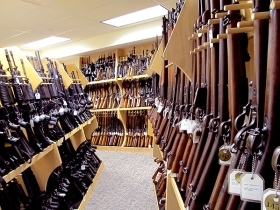In a finding that will do little to slow the debate about the origin of weapons used by Mexico’s bloody drug cartels, Justice Department data shows that close to 70 percent of firearms recovered in Mexico over the last five years can be traced back to the US.
Of 99,000 trace requests submitted by Mexican authorities over the past five years for firearms suspected of being used in crimes, the Bureau of Alcohol, Tobacco, Firearms, and Explosives (ATF) traced 68,000 to US manufacturers or importers, according to data published on its website,
However, ATF Special Agent John Hageman cautioned the data could not be seen as definitive proof that 70 percent of the weapons used by Mexican organized criminals come from the US. In 2009, Mexico’s military possessed 305,424 confiscated guns, and as, the ATF noted, the numbers provided Thursday represented only those trace requests voluntarily submitted to the bureau by authorities in Mexico. What’s more, around 30 percent of trace data left the firearms’ source country undetermined.
The data does show that Mexico’s criminals appear to be favoring more powerful weapons. Compared to 2007, when rifles accounted for some 28 percent of guns submitted by Mexico to the ATF for tracing, 2010 and 2011 saw figures of 59 and 43, respectively.
Hageman said the ATF had not broken the data down beyond the categorization of rifles, pistols, revolvers, shotguns, and “other,” and cautioned that the designation of a rifle did not necessarily refer to an assault weapon. Nonetheless, the ATF’s press release noted that Mexican authorities had reported a rise in the use of AK and AR-style assault rifles by organized criminal groups.
The trend of increasing rifle recoveries points to a militarization of violent crime in Mexico, as traffickers eschew pistols and revolvers in favor of more powerful weapons. The escalation in violence has left over 50,000 dead in Mexico during the time span the ATF data covers.
Tracing the flow of US weapons into Mexico has become a virtual bloodsport in both countries. In 2009, the General Accounting Office said (see pdf) that over 90 percent of the weapons used by criminal gangs in Mexico came from the United States. Gun lobbyists and other analysts say the weapons come from other sources, such as Central American military stocks, something InSight Crime has reported on numerous occasions.
Mexico’s government insists the US is not doing enough to shore up its border and slow the purchase and illegal transfer of weapons into criminals’ hands. The criticism is warranted. The ATF’s release of data comes amid news that the US House of Representatives voted to cut funding for the bureau’s multiple long guns sale reporting program. The program — the only measure the Obama administration has put in place to curb the flow of guns south — requires Federal Firearm Licensees (FFLs) in the border states of Texas, California, New Mexico and Arizona to report the sale of two or more rifles within five business days, if the rifles accept detachable magazines and ammunition of higher than .22 caliber.
The program has affected 8,500 FFLs in the four states, and the reports it generated led to 30 criminal cases with 100 defendants between them in its first six months, Hageman said. The House amendment must still pass the Senate before the program loses funding.
However, Mexico’s highest office has used the US weapons argument to deflect attention from its own failures. After Mexican criminals burned a casino in Monterrey last year, killing 52 people, in what appeared to be a local battle for control of these gambling houses, President Felipe Calderon said Mexico should not pay the consequences of the US inaction on this issue (see minutes 11-13 of video, below).
The new data released by the ATF is unlikely to calm either side. There exists no definitive proof that more of these guns did not cross over the US border with Mexico, nor is there proof that Mexican authorities did not selectively submit requests for guns they were confident had crossed the border.
Yet, in scientific circles, 99,000 would be a large enough sampling size to draw some, albeit preliminary, conclusions. And 68,000 weapons is, put simply, a lot. What’s more, numerous ATF agents on both sides of the border have told InSight Crime they believe that the vast majority of weapons used by large criminal groups come from the United States.
At the heart of the issue is the fact that guns are not easy to trace, mostly due to constant lobbying by gun advocates. The ATF is the only US government agency that conducts firearm traces, and there is no national registry in the United States. The ATF conducts its traces by tracking firearms purchases from initial importers or manufacturers through the chain of sales to licensed gun dealers, ultimately leading to a retail purchaser. Gun dealers are required to hold records of firearms transfers, but gun purchases at private auctions and gun fairs often cloud that trail. And requests that do not include all the data of the firearm make tracing that weapon nearly impossible.
The ATF press conference revealing trace data is an about-face in transparency from an agency that has come under increasing scrutiny, mostly for its controversial tactic of allowing weapons to “walk” to Mexico in the hopes these weapons would lead to arrests of high-level drug traffickers.
The so-called “Fast and Furious” case epitomized this strategy. Run from the bureau’s Phoenix office, Fast and Furious case agents monitored over 2,000 guns moving through US-based middlemen and presumably into the hands of Mexican criminal organizations. One of these weapons was used in a 2010 ambush on a US border patrol that resulted in the death of customs agent Brian Terry.

